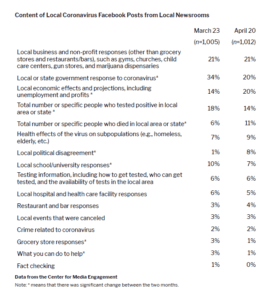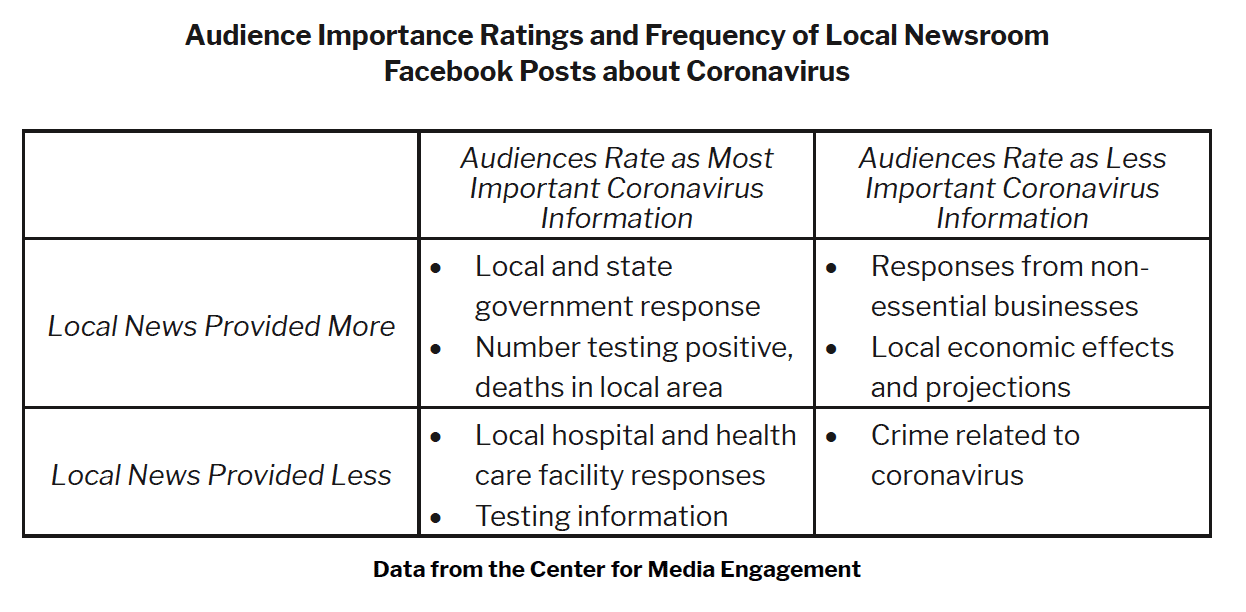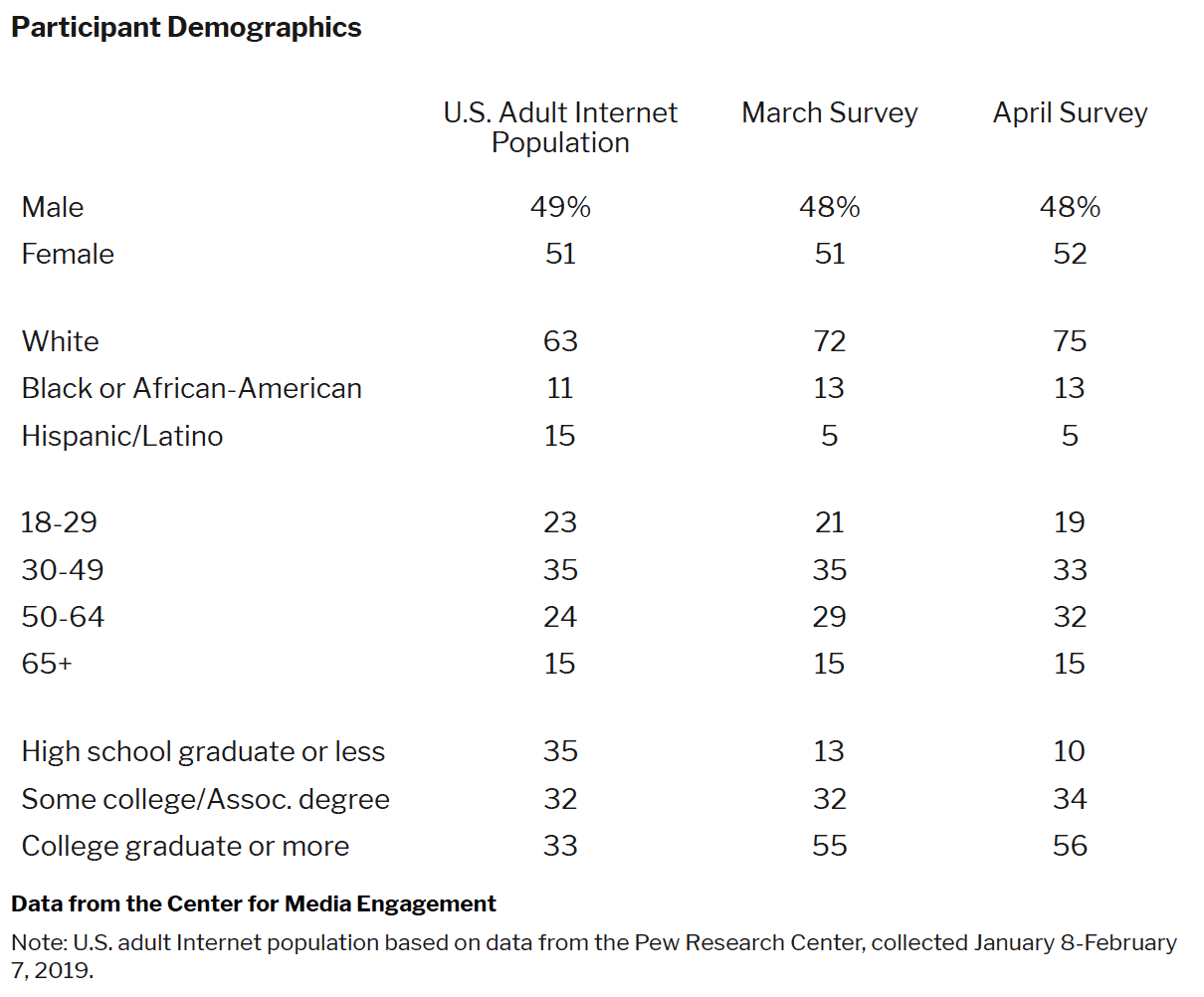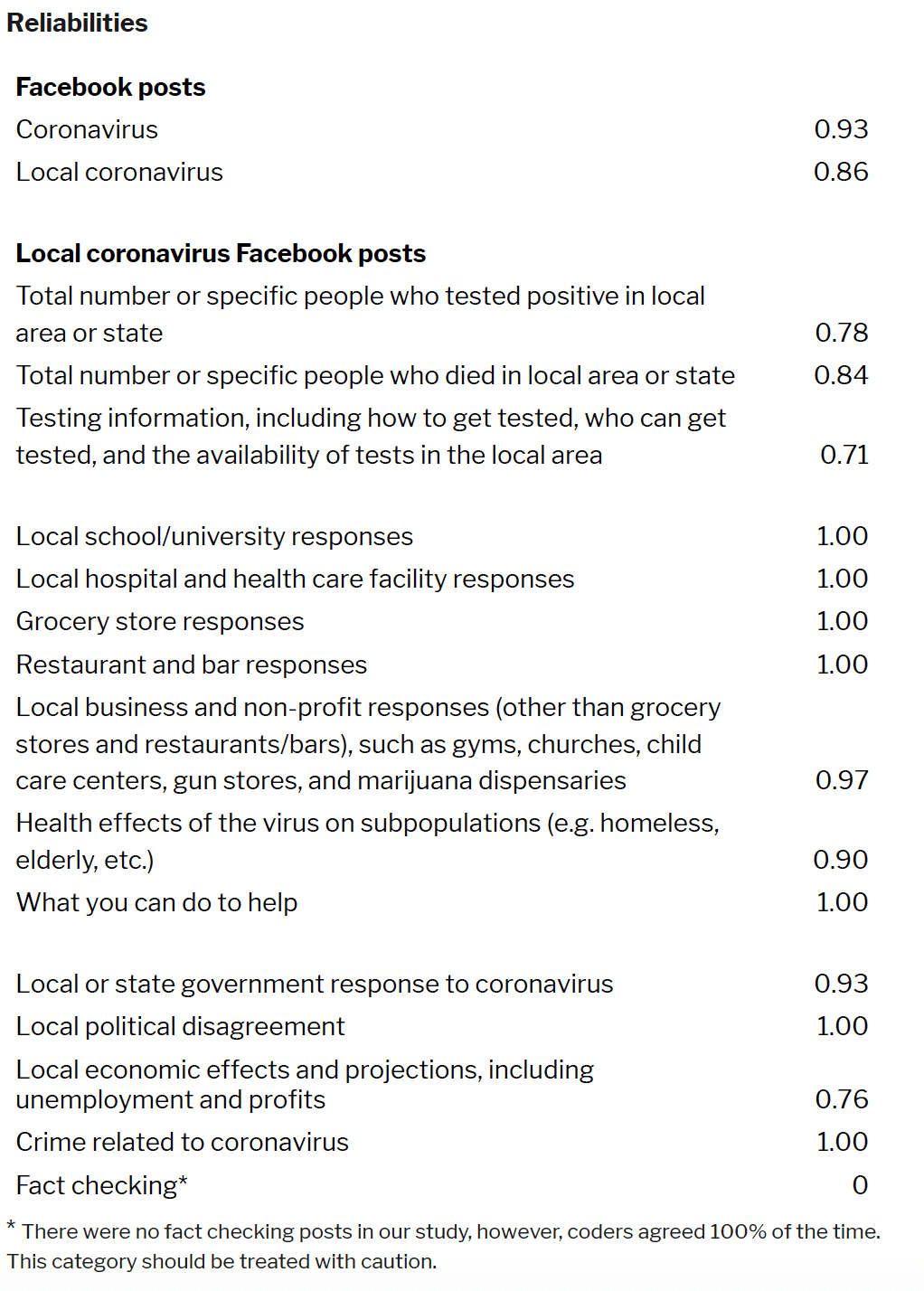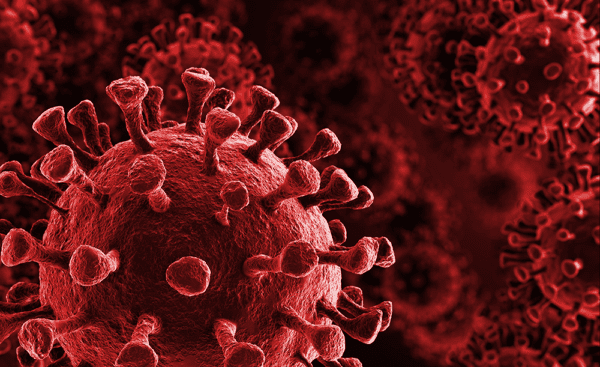
The Center for Media Engagement took a snapshot of local news’ Facebook posts and public perceptions of local coverage of the coronavirus pandemic and compared it with coverage and public opinion from one month earlier.
We found that local news outlets shifted their focus between March and April, with a greater emphasis on coverage of economic effects and projections and less focus on the state and local government’s response.
When we compared the coverage to what people said they wanted from local news, we found that audiences desired, and local newsrooms provided, information about how local and state governments are responding, the number testing positive in a local area, and the number of deaths in a local area. Audiences were less interested in coverage of coronavirus-related crime, and newsrooms did not share many Facebook posts on this topic.
Some local newsrooms’ Facebook posts also included topics that audiences did not rate as important, including how non-essential businesses (e.g., gyms, churches, etc.) are responding to the coronavirus and the local economic effects and projections. Audiences did want information about testing and local hospital and health care facility responses, yet there were fewer posts about these topics compared to others. These topics represent an opportunity for newsrooms to rethink coverage to meet audience needs.
THE COVERAGE PEOPLE WANT FROM LOCAL NEWS AND HOW NEEDS ARE CHANGING
In March, we surveyed 999 people about what information they wanted from local news organizations regarding the coronavirus pandemic. Four weeks later, we contacted the same people and again asked “As of today, how important is it to you that your local news organizations share coronavirus information about” followed by a list of 26 topics. Survey participants were asked to respond from “not at all important” (0) to “very important” (3).
A total of 899 people responded to both surveys. In the March survey, the top priorities were local health updates and information about local entities that provide critical services in people’s day-to-day lives. These priorities largely held constant in the April survey. We also asked about four additional news topics in April: timing of lifted restrictions, how the local economy is being affected, how people are providing emotional support to others, and how people are coping with activities such as homeschooling and working from home. With the addition of these new topics, there were four clusters of topics, as shown in the table below in order of importance.
Overall, many news categories were deemed less important in April than in March. Of our 22 news categories from the first survey, all but five were rated as significantly lower in importance in the second survey. None of the categories was rated as significantly more important.
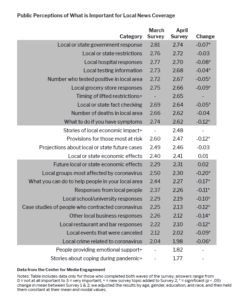 Additionally, in both the March and April surveys, we asked respondents to rate how much attention they had then been paying to national and local news about coronavirus from “none at all” (0) to “a great deal” (4). For national news, attention to coronavirus dropped significantly from March when the average was 3.29 to an average of 2.99 in April. This pattern holds for local news, with an average of 3.11 in March and 2.83 in April.
Additionally, in both the March and April surveys, we asked respondents to rate how much attention they had then been paying to national and local news about coronavirus from “none at all” (0) to “a great deal” (4). For national news, attention to coronavirus dropped significantly from March when the average was 3.29 to an average of 2.99 in April. This pattern holds for local news, with an average of 3.11 in March and 2.83 in April.
CHANGES IN THE COVERAGE LOCAL NEWSROOMS ARE PROVIDING ON FACEBOOK
Government and Business Coverage Remain Most Common in Local News Facebook Posts
The focus of local coronavirus coverage in news Facebook posts was somewhat consistent between March 23 and April 20, with government and business coverage as the most common topics. There were some notable shifts, however.
- Coverage of government responses significantly declined. In March, 34% of local news outlets’ Facebook posts were about local and state responses to coronavirus. In April, just 20% of posts were about government responses.
- Local news outlets had fewer Facebook posts about the number of people testing positive (14% vs. 18% one month earlier) and school and university responses (7% vs. 10% one month earlier).
- Local news outlets had more frequent Facebook posts about the economic effects of coronavirus (20% vs. 14% one month earlier), the number of deaths (11% vs. 6% one month earlier), and local political disagreement (8% vs. 1% one month earlier).
- Unlike on March 23, there were several differences between broadcast and newspaper Facebook posts. Newspapers reported significantly more on the response of grocery stores,1 local political disagreement,2 and economic effects and projections3 than TV news. TV news Facebook posts focused more on positive tests than did newspaper posts.4
Comparing Local News’ Coronavirus Facebook Posts with Audience Needs
When we compared the analysis of local news Facebook posts with what people said they wanted from local news, there were several noteworthy patterns.
As shown in the chart below, local newsroom Facebook content aligned with audience preferences on several topics. Audiences desired, and local newsrooms provided, information about how local and state governments are responding, the number testing positive in a local area, and the number of deaths in a local area. Audiences were less interested in coverage of coronavirus-related crime and newsrooms did not share many Facebook posts on this topic.
There were instances in which there seemed to be a mismatch between audience preferences and newsrooms’ Facebook posts. There were several topics that had a higher percentage of Facebook posts though audiences rated the topics as less important than others. These topics included how non-essential businesses (e.g., gyms, churches, etc.) are responding to the coronavirus and the local economic effects and projections. Audiences also wanted coronavirus information about testing and local hospital and health care facility responses, yet there were fewer Facebook posts in our sample about these topics compared to others. These differences between audience ratings and Facebook coverage provide an opportunity for newsrooms to consider whether their coverage is meeting audience needs.
Local Political Disagreement Garnered Strongest Facebook Engagement
We examined the number of likes, comments, and shares for each of the categories we analyzed in the local coronavirus news Facebook posts. Overall, news posts about local political disagreement over the pandemic overwhelmingly received the most likes, comments, and shares on April 20, in contrast to March 23, when health information or government responses received the most engagement.
- Facebook likes were highest for stories about local political disagreement (around 93.5 likes, the median value). Stories about local people dealing with the virus (around 78 likes) and government responses (around 43 likes) also yielded a high number of likes. On March 23, the most-liked stories were about government responses to the virus (around 35.5 likes), how local hospitals were faring (around 24 likes), and how grocery stores were responding (around 33 likes).
- Comments were also highest for stories about local political disagreement (around 278.5 comments), followed by stories about local people dealing with the virus (around 182 comments). These results were very different from March 23, where comments were most frequent on stories about local area or state deaths from coronavirus (around 24.5 comments), followed by information about coronavirus testing (around 18 comments) and government responses (around 17 comments).
- Shares were highest for stories about local political disagreement (around 50 shares), followed by stories about local people (around 35 shares), and health projections about the virus (around 26 shares). On March 23, the most-shared stories were about what to do if someone displayed coronavirus symptoms (around 42.5 shares),5 followed by information about the number of deaths in a local area or state (around 38 shares) and coronavirus-related crime (around 34 shares).
Coronavirus Dominated Local News’ Facebook Posts
- 69% of Facebook posts from local newspaper and television news organizations focused on coronavirus, down from 81% one month earlier.
- Of those Facebook posts that were about coronavirus, 61% presented local coverage. The remaining 39% were international or national coverage or coverage from other states. This is down slightly from the prior month, when 65% of coronavirus posts included local coverage.
- Replicating the finding from the month before, newspaper coronavirus Facebook posts were more likely to be local (70%) than television news Facebook posts (53%).6
Coronavirus Facebook Posts Garnered More Engagement
- Facebook posts about topics other than coronavirus had around 8 likes, 2 comments, and 4 shares (median values), compared to posts about coronavirus, which had around 24 likes, 12 comments, and 10 shares.7 We also saw higher engagement with coronavirus posts in March.
- Local coronavirus posts had around 12 shares, compared to 7 shares on non-local coronavirus posts. There were no differences in the number of likes or comments depending on whether the coronavirus posts were local or not.8 In March, local coronavirus posts garnered more comments, but there were not differences based on likes or shares.
Methodology
Survey
This report was made possible thanks to funding from the Democracy Fund, the William and Flora Hewlett Foundation, The John S. and James L. Knight Foundation, and The University of Texas at Austin. On March 23-25, 2020, we launched a survey of 999 people through Prolific. Prolific has a pool of roughly 16,000 survey panelists in the U.S. that can opt-in to take surveys and are paid for their participation through Prolific. On April 20-22, 2020, we launched a second survey through Prolific that went to the same respondents as the first survey. During both survey waves, most people completed the survey on the first day it was fielded. We received 899 responses to the second survey, a recontact rate of 90%. Survey questions did not change, but we added additional questions to cover emerging topics related to coronavirus. These additional questions were based on an open-ended survey question posed to 98 respondents on Amazon’s Mechanical Turk. The question was “We are interested in what types of coronavirus coverage people would like to see in their local newspapers and TV stations. In your own words, what coverage of the coronavirus would you like to see more of in the local news?” Based on these responses, we added four new questions, which are noted in the results above and in the question-wording section below.
Participant Demographics
The survey was neither a representative nor a random sample, although quotas were put in place for age, gender, and race. The overall demographics of the sample, compared to Pew Research, are included in the table below. As the table shows, our sample is significantly more educated and more white than the U.S. adult Internet population. Because our sample is not representative, we included covariates when computing our mean values and then reported means adjusted for demographics. The demographic controls did not change our substantive conclusions.
Question Wording
With response options of very important (3), somewhat important, not too important, and not at all important (0), survey respondents were asked the following questions.
As of today, how important is it to you that your local news organizations share coronavirus information about:
- The number of people in your local area testing positive for coronavirus
- The number of deaths from coronavirus in your local area
- What to do if you have coronavirus symptoms
- Coronavirus testing, such as how to get tested, who can get tested, and the availability of tests in your local area
- Case studies of local people who contracted coronavirus
- Projections about future cases of coronavirus in your local area or state
- What local schools and universities are doing in response to coronavirus
- What local hospitals are doing in response
- What local people are doing in response
- What local grocery stores are doing in response
- What local restaurants and bars are doing in response
- What other types of local businesses are doing in response
- Coping with new activities like homeschooling and working from home (new topic)
- Stories of how people are emotionally supporting each other or providing positivity (new topic)
- Events in your local area that are canceled
- What local provisions are available for people without means or most at risk (e.g., homeless, laid off, elderly)
- What local groups are most affected by coronavirus (e.g., elderly, etc.)
- What you can do to help people in your local area affected by coronavirus
- What local or state government is doing in response
- When and how restrictions in your state or local area will be lifted (new topic)
- How your local or state economy is being affected by the coronavirus (new topic)
- Local crime related to coronavirus (e.g., stolen toilet paper or price gouging)
- Fact-checking misinformation circulating in your local area or state
- A list of restrictions in your local area or state
- Local or statewide economic effects (e.g., unemployment)
- Projections about the economic future of your local area or state
With response options of a great deal (4), a lot, a moderate amount, a little, or none at all (0), we asked the following questions about news attention:
- How much attention, if at all, have you been paying to national news about coronavirus?
- How much attention, if at all, have you been paying to your state and local news about coronavirus?
Analysis of Facebook Posts
Next, we used Facebook’s CrowdTangle platform to gather Facebook posts from newspapers in the state capitals and from one randomly selected television station (ABC, CBS, NBC, or FOX) in each of Nielsen’s 210 Designated Market Areas (DMAs). This returned 1,262 posts from newspapers and 7,446 posts from television stations.
We randomly sampled 290 posts (130 from newspapers and 160 from television) and conducted a reliability analysis on whether the posts (1) were related to coronavirus and, if so, (2) were local stories. After obtaining reliability, we examined an additional 2,145 randomly sampled posts for a total of 2,435 posts analyzed.
For posts that were both about coronavirus and local, we randomly sampled 200 posts (100 from newspapers and 100 from television) and conducted a reliability analysis. After obtaining reliability, we examined additional randomly sampled posts, split between newspaper and television, for a total of 1,012 posts analyzed.
Reliabilities were computed using Krippendorff’s alpha. The metric runs from 0, indicating a lack of reliability and extensive disagreement among people examining the same content, to 1, indicating perfect agreement among people examining the content. Scores greater than 0.80 indicate strong reliability and those greater than 0.67 indicate acceptable levels of reliability.
SUGGESTED CITATION:
Gina M. Masullo, Jay Jennings, Jessica R. Collier, Ashley Muddiman, Caroline Murray, Gabrielle Chavez, Katalina Deaven, Natalie Deller, Jacob Gursky, Katie Joseff, Ellery Wadman-Goetsch, Tamar Wilner, and Natalie Jomini Stroud. (2020, May). Covering coronavirus: How audience needs are changing and how newsroom coverage compares. Center for Media Engagement. https://mediaengagement.org/research/ coronavirus-coverage-changes
- χ2(1, 1012) = 4.64, Phi = .07, p = .03. [↩]
- χ2(1, 1012) = 6.89, Phi = .08, p = .01. [↩]
- χ2(1, 1012) = 7.96, Phi = .09, p = .01. [↩]
- χ2(1, 1012) = 6.85, Phi = .08, p = .01. [↩]
- There were too few cases of this category to include in the April analysis. [↩]
- χ2(1, 1667) = 47.79, Phi = 0.17, p < .001. [↩]
- Mann-Whitney Z = 14.74, p < .01 for likes; 14.94, p < .01 for comments; and 9.24, p < .01 for shares comparing coronavirus to non-coronavirus posts. [↩]
- Mann-Whitney Z = 4.30, p < .01 for shares comparing local coronavirus to non-local coronavirus posts. [↩]








